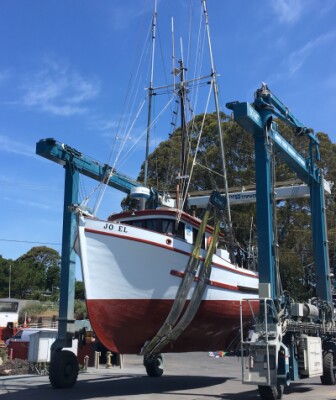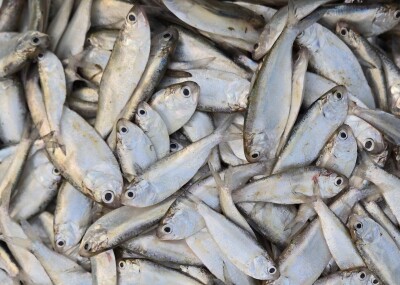ATY Northeast
Extension adds to deck space; Canadian yard builds dragger
At the end of February, the 42-foot gillnetter Nancy Beth was back in the water after a 4-foot extension was added to its stern. The work was done by Rich Fuka and Steve Perkins at Harborside Boat Repair, which operates out of Ram Point Marina in Wakefield, R.I.
The boat's owner, Aaron Gewirtz, "wanted a little more stability in the stern, and he definitely needed more deck space," Fuka says. He adds that with its additional length, the boat should be faster.
"We molded the hull so it has a down turn to it, so it gives a lifting capability for a little more planing speed, rather than the hull squatting in the stern. We adjusted the extension to give it a positive push, sort of like lifting strakes in the stern," he explains.
The extension was molded off the hull's sides and bottom and then faired into the original hull after grinding down the gel coat. "A lot of attention was paid to fairing it in to make it look like it was part of the boat," Fuka says.
The only way to tell that the new 4-foot addition wasn't originally part of the boat is that Gewirtz left the boat's name and hailing port where it had been on the side of the hull, instead of repainting it next to the new transom.
Despite lengthening the hull, the Harborside Boat Repair crew didn't move the rudderpost farther aft. Fuka says he's not sure if that will lead to any issues, but "we've done it before on a 36 Bruno, and the hull reacted just the way it had before to the rudder. I'm assuming the rudder will be able to compensate for the additional length."
The extension is composite construction, featuring Nida-Core. Fuka describes Nida-Core as "the weapon of choice" at the boatyard. "We've had success with it for quite a while here."
Fuka and Perkins do seem to have a reputation for working over the back ends of fishing boats. A little over a year ago, they put a stern ramp on the Pontos, a Novi-style boat owned by Ricky Jones of Montauk, N.Y.
In this case, they added the ramp while the boat was in the water. "We made the stern ramp in the shop and then brought it down and installed it," Fuka says.
Another time, "the whole back stern of the boat was replaced," says Fuka. That was on a dragger owned by Rhode Island fisherman Phil Ruhle Jr.
When Fuka isn't repairing boats, he's working as president of the Rhode Island Fishermen's Alliance.
The Nanny Bessie left the dock at Meteghan River, Nova Scotia, on its initial sea trial the last week in February. A.F. Theriault & Son built the 63' x 23' x 10' dragger for W.M. Schrader Fisheries in Larry's River, Nova Scotia. It will fish for redfish and shrimp, as well as haddock, pollock and cod. She can pack up to 100,000 pounds in her hold, says the boatyard's Gilles Theriault.
The Nanny Bessie is built from an in-house design that has been used for 10 to 15 draggers. This is a solid fiberglass hull that runs from 3/4-inch to 1-inch thick. The bulkheads and decks — 2 inches thick — are cored with Divinycell.
For power the dragger has a 590-hp Mitsubishi S6R-1MPTA main engine bolted to a marine gear with a 6.1:1 ratio that turns a 70" x 68" prop.
A 400-hp Mitsubishi S6B3 drives the main hydraulic pump to power a pair of A.F. Theriault & Son-built split winches — holding 500 fathoms of 3/4-inch cable — and a stern-mounted net drum with a 7-foot diameter.
The sheer line kicks up a bit in the stern quarters, which is a design feature not seen on most draggers built in the states. "It does have a little boat characteristic," as Theriault describes it. "It's not like a square box."
There are accommodations for six crewmen who will be going on trips of four to five days, Theriault says.
While the Nanny Bessie was undergoing sea trials, the crew at A.F. Theriault was building a 66-foot fiberglass longliner for a fisherman in Sambro, Nova Scotia. The longliner is scheduled for a summer completion. — Michael Crowley
ATY West
New gillnetters are in demand; Combo boats occupy Ore. yard
It wasn't so long ago that a new gillnetter going to Alaska's Prince William Sound was an exception. Fishermen there were struggling, but now with a couple of good seasons behind them, salmon fishermen are looking to replace their old boats with something new.
In addition, many fishermen are looking to build a larger boat. "The fishery has changed," says Tom Day at Hard Drive Marine in Bellingham, Wash. "All the inside fisheries with smaller, older boats are gone because the quota has gone to sport fishermen. Everybody is having to fish in the open ocean and needs bigger boats."
Day figures as many as 30 new boats could be going to Prince William Sound for this season's salmon fishery. Hard Drive Marine is involved in sending four of those boats north and has contracts to build three more aluminum gillnetters for the 2014 season.
One of the boats currently under construction measures 34' x 12' and is being finished off at Petrzelka Bros. in Mount Vernon, Wash. Another 34-footer will be finished off by its owner, though he won't have a whole lot to do. Hard Drive Marine is doing all the aluminum work — hull, deck and cabin — as well as installing the engines, hydraulics and water jets. That pretty much leaves the interior and wiring.
Both of those boats will have twin 370-hp Iveco engines hooked up to 305 UltraJets.
The third 34' x 12' gillnetter Hard Drive Marine is building will go out the door completely finished. She'll have a sliding reel and a fish-hold capacity of about 10,000 pounds in six holds, says Day. She will also have a head, shower and bunks for three to five crewmen.
For power this 34-footer will have a pair of 370-hp Yanmars and 305 UltraJets. Day says he guesses the boat will go in the "low- to mid-40-knot range. The last one we did had Hamilton [water jets] and smaller Yanmars but did 35 knots. I figure we'll get at least another seven because of the increased jet volume and horsepower."
The gillnetter with the HamiltonJets was delivered in December 2012 and is the only gillnetter Hard Drive Marine is sending to Prince William Sound without an UltraJet. The three boats on line for the 2014 season "most likely will have UltraJets," says Day.
"I guarantee you that if the three boats we put out this season perform, some other builders will be requested to install UltraJets," Day adds.
In Charleston, Ore., Giddings Boat Works has the hull of the 67' x 25' Patriot plated up, and in early February the hull for the 72' x 28' Miss Emily had started to take shape.
"The most exciting thing about these boats," says the boatyard's Mike Lee, "is that they are local. Most boats built in the last few years have gone north."
The Patriot is being built for Mike Pettis of Newport, Ore., and the Miss Emily for Todd Whaley of Brookings, Ore.
Both boats will be used for shrimping, crabbing and tendering, and each will have a Cummins QSK19 main engine, though the Patriot's is rated at 600 horsepower and the Miss Emily's at 660 horsepower.
The steel boats are being built to older designs from Jensen Maritime Consultants in Seattle that were then modified to make them wider and deeper. Tullio Celano of Crescere Marine Engineering in Columbia City, Ore., modified the Patriot, and Jensen did the same to the Miss Emily.
Lee says they hope to have the Patriot done in time to put in some shrimping trips. The season is over the end of October. He wants to have the Miss Emily in the water by mid to late November, in time for the start of Dungeness crab season.
Besides building the Patriot and the Miss Emily, Giddings Boat Works has a number of repair jobs coming up including building new bait wells in an albacore boat and putting an aluminum house on the Kodiak, Alaska-based Marcy J, which is owned by Harold Jones.
"We are prebuilding the house for the Marcy J," says Lee. "We'll have most of it done by the time the boat shows up in April." — Michael Crowley
ATY South
Menhaden steamer delivered; watermen can sell their stories
The Omega Shipyard at Moss Point, Miss., delivered the Rappahannock, a 196' x 40' menhaden steamer, to Omega Protein's processing plant in Reedville, Va. She will be harvesting menhaden in Chesapeake Bay and off the Atlantic coast.
Omega Shipyard is also finishing another menhaden steamer, the Fleeton, which will be delivered to Reedville in April. (The use of the term "steamer" has been carried over from when the boats were steam powered.)
The hulls of the two boats were originally offshore oil supply vessels. O.W. Brown, the shipyard's general manager, says the conversion entailed taking out large fuel tanks and converting the space to fish holds. "We gutted her all and installed a completely new interior for fishing needs," he says.
"The fish holds are slightly larger than on our standard boats," he adds. "We doubled the tonnage of the refrigeration to improve the quality of our product."
Although the 184' x 38' Fleeton is smaller than the Rappahannock, the two boats have the same machinery, including two 1,500-hp Caterpillar 3512C main engines bolted to Twin Disc MGX-5600 marine transmissions with 6.04:1 ratios. The propellers are 84" x 69".
Currently Omega Shipyard is servicing Moss Point steamers. "Some of it is just annual maintenance and then there is some fairly extensive work that has to be done," says Brown.
The new Chesapeake Bay boats will replace a pair of menhaden steamers. Another older boat will be retired this year as a result of the Atlantic States Marine Fisheries Commission recent vote to reduce the harvest of Atlantic coastal menhaden by 20 percent. Omega Protein will fish seven boats in the 2013 fishing season.
The Coastal Heritage Alliance is a nonprofit organization dedicated to the advancement of this country's commercial fishing heritage.
Most important to this column is that the group preserves historic fishing boats. Coastal Heritage Alliance is working on two sailing skipjacks. One of them is the Martha Lewis, a traditional sailing skipjack owned by the Chesapeake Heritage Conservancy. She is Coast Guard inspected and used as a floating classroom and an oyster dredge boat.
Michael Vlahovich, master builder and the Coastal Heritage Alliance's founding director, says he will replace a chine log on the port side of the Martha Lewis and some bottom staving.
As mentioned in this column in the January 2013 issue, Coastal Heritage Alliance is doing a major restoration of the skipjack Kathryn at Scott's Cove Marina in Chance, Md. Built in 1901, the National Park Service lists the Kathryn as a National Historic Landmark.
"We salvaged the skeg and not much else," says Vlahovich. "The keel has been totally removed and replaced. The vessel needs reframing, and all of the bottom and transom need to be replaced. There is not much on her that doesn't need something."
As part of the project, once a month the Coastal Heritage Alliance sponsors a three-day event where volunteers from Washington College in Chestertown, Md., work on the boat under Vlahovich's direction.
"It is a very good program because it introduces so many people to the boat and the culture," he says. "Everyone who comes seems to realize the merit in saving these old boats and the significance of our watermen's culture."
Another program co-sponsored by the Coastal Heritage Alliance is Watermen Heritage Tour Training. Members of the group assist commercial fishermen in using their own stories to create a "dramatic tour" for visitors. The purpose is to provide watermen with the skills to participate in the growing geotourism industry to help supplement their incomes.
The program was initiated in Maryland under a partnership program that included the Chesapeake Conservancy, the Maryland Watermen's Association, the Chesapeake Bay Maritime Museum and the Coastal Heritage Alliance.
In February, the program was expanded to Virginia, and a group worked with watermen in Kilmarnock on ways they can cash in on geotourism. "I watched tourism totally displace the traditional culture at St. Michaels [Md.]. We are taking a pro-active approach to preserving the culture in other areas by having watermen tell their own stories on their own boats," Vlahovich says.
— Larry Chowning






